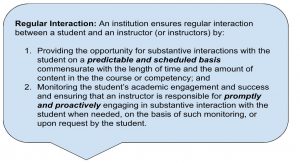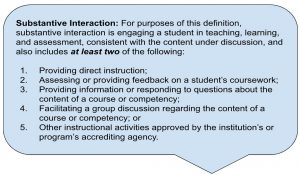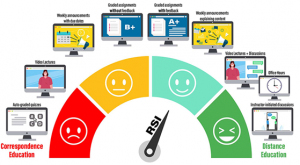Last revised: 6/29/2022 by ess
Overview:
This article provides examples for meeting the federal requirement for online or distance learning courses to “support regular and substantive interaction (RSI) between the students and the instructor, synchronously or asynchronously” (Downs, 2021).
Regular and Substantive Interaction (RSI) Background
In order for online students to receive financial aid, they must be enrolled in distance education courses, not correspondence courses. The Higher Education Opportunity Act (HEOA) of 2008 600.2 differentiates distance education from correspondence courses by stating distance education is “education that uses one or more technologies to deliver instruction to students who are separated from the instructor and that supports “regular and substantive interaction” between the students and the instructor, synchronously or asynchronously” (HEOA, 2008). For years higher education institutions struggled defining regular and substantive interaction (RSI) because federal requirements and expectations surrounding RSI were somewhat unclear. On September 2, 2020 the Department of Education issued Final Rules on Distance Education and Innovation to help clarify the Regular and Substantive Interaction (RSI) requirements.
What is RSI?
While there is still room for interpretation, the final rules issued by the Department of Education help shape the definitions of “regular and substantive interaction”. Let’s review how the US Department of Labor defines RSI by breaking it down into the following two parts (U.S. Dept of Ed, RSI Regulation):


Ways to Meet RSI in Online Courses
The following examples outline some of the types of interactions that would help faculty meet the regular and substantive interaction (RSI) requirement (SUNY, esc.edu) (Note: At least two types of interactions are required to meet RSI):
- weekly course announcements tailored to the course;
- weekly summaries or highlights of discussion threads;
- regularly scheduled office hours and/or online review/help sessions;
- regular announcements and/or emails previewing or reviewing difficult content;
- listing out questions for students to ponder when interacting with the assigned materials each week;
- instructor-facilitated discussions illustrating real life applications of course concepts.
- personalized, specific, and detailed feedback to individual students.
SUNY Empire State College created the following creative commons RSI dashboard image (shown below) to help faculty visualize the RSI regulations in terms of a scale. Note: Activities aligning more closely with “correspondence education” are on the left and “distance education” are on the right.

Image credit: RSI Dashboard SUNY Empire State College ![]()
For more information visit:
- SUNY Online, RSI References and Resources at https://oscqr.suny.edu/rsi/rsi-references-and-resources/.
References:
- Downs, L. (2021, August 26). Regular and Substantive Interaction Refresh: Reviewing & Sharing Our Best Interpretation of Current Guidance and Requirements. Western Cooperative for Educational Telecommunications (WCET).
- Higher Education Opportunity Act (HEOA)- Public Law 110-315. (August 14, 2008). Sec. 102, Definition of institution of higher education for purposes of title IV programs.
- SUNY Empire State College. Regular and Substantive Interaction. Background: Definitions of Distance Education and Correspondence Courses.
- U.S. Department of Education Negotiated Rulemaking for Higher Education. RSI regulation – see pp. 339-341. Found in the Department of Education, Office of Postsecondary Education, Distance Education and Innovation.